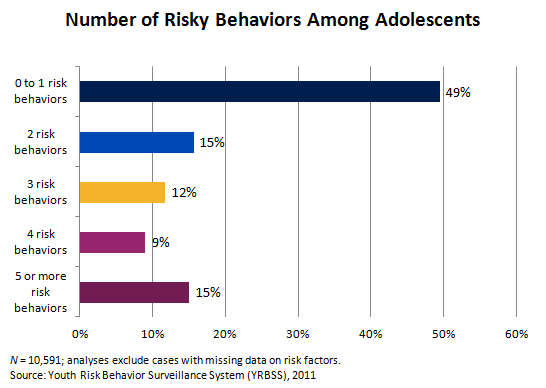Youth who receive special education services under the Individuals with Disabilities Education Act (IDEA 2004) and especially young adults of transition age, should be involved in planning for life after high school as early as possible and no later than age 16. Transition services should stem from the individual youth’s needs and strengths, ensuring that planning takes into account his or her interests, preferences, and desires for the future.
Risks and Protective Factors
Experimenting and risk-taking are part of adolescent life and play a role in adolescent development. Taking risks helps adolescents establish their identities and learn from their successes as well as their failures. Adults can help adolescents by encouraging them to take the positive steps that strengthen them and lessen chances for negative behavior.
Positive Risks and Protective Factors
There are many positive risks teens can take. Playing sports, trying a new activity, volunteering or working, taking a harder class at school, and making new friends are all examples of positive risk-taking and are usually a healthy part of growing up.
Teens who are engaged in learning and in meaningful activities; who have a good self-concept and have control of their emotions; who live in stable situations; and who are healthy and safe benefit from protective factors in their lives, which help them learn and grow.
Negative Risks
Then there are negative risks, such as alcohol and drug use, unsafe driving, violence, sex, and depression, which worry parents and trouble communities. Indeed, studies suggest that half of all behavioral risks first appear during adolescence.
The good news is that about half of high school students reported engaging in very few risky behaviors (none or one) during the prior year. Of concern is that nearly one in four (24%) reported engaging in four or five risky behaviors during that time period.

Table 1: Risky Behaviors Among Adolescents
| Behavior | Percentage of Adolescents |
|---|---|
| 0 to 1 risk behaviors | 49% |
| 2 risk behaviors | 15% |
| 3 risk behaviors | 12% |
| 4 risk behaviors | 9% |
| 5 or more risk behaviors | 15% |
Figuring out which teens are engaging in negative risks is complex. The challenge is to figure out which adolescent is experimenting with a risky behavior and which ones are engaged in serious risk-taking that has the potential to harm their health and well-being. A teen with many risks may be one who needs additional attention from caring professionals and who may benefit from behavioral counseling and coordinated follow-up services.
Protective Factors
Personal
- Ability to control one’s emotions
- Positive self-concept
- Good coping and problem-solving skills
- Engaging in learning
- Social skills
- Healthy physical development free from disease and injury
- Feeling connected and engaged with at least two areas outside of family: school/afterschool, positive peers, athletics, employment, religion, culture, or the arts
Family
- Stability and predictability
- Rules, limits, monitoring, structure (age-appropriate)
- Supportive relationships with family members
- Clear expectations for behavior and values
School and Community
Adolescent Health: Think, Act, Grow® and the logo design are registered trademarks of the U.S. Department of Health and Human Services.
Youth Briefs
Research links early leadership with increased self-efficacy and suggests that leadership can help youth to develop decision making and interpersonal skills that support successes in the workforce and adulthood. In addition, young leaders tend to be more involved in their communities, and have lower dropout rates than their peers. Youth leaders also show considerable benefits for their communities, providing valuable insight into the needs and interests of young people
Statistics reflecting the number of youth suffering from mental health, substance abuse, and co-occurring disorders highlight the necessity for schools, families, support staff, and communities to work together to develop targeted, coordinated, and comprehensive transition plans for young people with a history of mental health needs and/or substance abuse.
Nearly 30,000 youth aged out of foster care in Fiscal Year 2009, which represents nine percent of the young people involved in the foster care system that year. This transition can be challenging for youth, especially youth who have grown up in the child welfare system.
Research has demonstrated that as many as one in five children/youth have a diagnosable mental health disorder. Read about how coordination between public service agencies can improve treatment for these youth.
Civic engagement has the potential to empower young adults, increase their self-determination, and give them the skills and self-confidence they need to enter the workforce. Read about one youth’s experience in AmeriCorps National Civilian Community Corps (NCCC).






